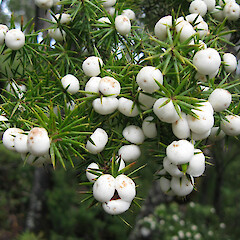Leptecophylla juniperina subsp. juniperina
Common name
prickly mingimingi, mingimingi
Synonyms
Epacris juniperina J.R.Forst. et G.Forst., Cyathodes acerosa (Gaertn.) Roem. et Schult., Ardisia acerosa Gaertn., Cyathodes acerosa (Gaertn.) Roem. et Schult. var. acerosa, Cyathodes acerosa var. parvifolia Hook.f., Cyathodes articulata Colenso, Cyathodes juniperina (J.R.Forst. et G.Forst.) Druce, Styphelia juniperina (G.Forst.) Pers., Styphelia acerosa F.Muell., Leucopogon forsteri A.Rich. (nom. illegit.)
Family
Ericaceae
Flora category
Vascular – Native
Endemic taxon
Yes
Endemic genus
No
Endemic family
No
Structural class
Trees & Shrubs - Dicotyledons
NVS code
The National Vegetation Survey (NVS) Databank is a physical archive and electronic databank containing records of over 94,000 vegetation survey plots - including data from over 19,000 permanent plots. NVS maintains a standard set of species code abbreviations that correspond to standard scientific plant names from the Ngä Tipu o Aotearoa - New Zealand Plants database.
LEPJSJ
Chromosome number
2n = 20
Current conservation status
The conservation status of all known New Zealand vascular plant taxa at the rank of species and below were reassessed in 2017 using the New Zealand Threat Classification System (NZTCS) – more information about this can be found on the NZTCS website. This report includes a statistical summary and brief notes on changes since 2012 and replaces all previous NZTCS lists for vascular plants.
Please note, threat classifications are often suggested by authors when publications fall between NZTCS assessment periods – an interim threat classification status has not been assessed by the NZTCS panel.
- Conservation status of New Zealand indigenous vascular plants, 2017 . 2018. Peter J. de Lange, Jeremy R. Rolfe, John W. Barkla, Shannel P. Courtney, Paul D. Champion, Leon R. Perrie, Sarah M. Beadel, Kerry A. Ford, Ilse Breitwieser, Ines Schönberger, Rowan Hindmarsh-Walls, Peter B. Heenan and Kate Ladley. Department of Conservation. Source: NZTCS and licensed by DOC for reuse under the Creative Commons Attribution 4.0 International licence.
2017 | Not Threatened | Qualifiers: SO
Previous conservation statuses
2012 | Not Threatened
2009 | Not Threatened
2004 | Not Threatened
Brief description
Bushy prickly shrub bearing hard narrow sharp leaves that are white underneath and pink, red, red-black or white fruit. Leaves variable in shape and in two forms: 6-15mm long mainly in the west of both islands, and 7-10mm long mainly in the east of both islands (both around 1mm wide).
Distribution
Indigenous. New Zealand (North, South and Stewart Islands), also Australia (Tasmania only)
Habitat
Coastal to montane, in scrub and forest.
Detailed description
Dioecious, compact or tall shrubs 0.4-2.0 m tall. Bark firm, fibrous, weakly tessellated and furrowed, dark grey brown or dark brown. Stems grey, brown or grey brown; branchlets usually brown but occasionally yellow-brown or red-brown, rounded, scabrous or puberulent. Leaves spreading or occasionally reflexed, dark green, bronze-green or green, narrowly ovate, 4.0-18.0 × 1.0-2.1 mm, apex acute, tip pungent, 0.4-1.6 mm long, margin flat, glabrous or ciliolate toward apex; upper surface glabrous or puberulent at base, lower surface with intervenal papillae and 5 veins; petiole erect 0.6-1.7 mm long, appressed to stem, glabrous or puberulent on the upper surface. Flowers sickly sweet fragrant, solitary, terminal and axillary on erect or recurved pedicels 2-5 mm long in males, 1.3-3.0 mm in females; bracts ovate, 0.5-0.9 × 0.6-1.4 mm, obtuse, glabrous, margin usually ciliolate at the apex; bracteoles and sepals ovate or elliptic, obtuse, glabrous; bracteoles 8-24 per flower, imbricate, 1.2-2.4 × 1.1-2.0 mm; sepals 1.7-3.1 × 1.1-2.3 mm. Corolla tube white or cream, campanulate, exceeding the calyx, 1.5-2.8 mm long in males, 1.6-2.8 mm long in females, usually glabrous; lobes white or cream, shorter than tube 1.1-2.3 mm long, apex acute, glabrous or with short, sparse hairs. Anthers of male flowers 1.1-2.0 mm long, half-exserted; filaments 0.2-0.5 mm long, slightly exserted and visible between the lobes. Ovary ± spherical, 0.5-1.0 × 0.6-1.3 mm, glabrous, 4-6-celled; style straight, glabrous, attenuate from the ovary, 1.0-1.8 mm long in males, 0.9-1.5 mm long in females; stigma 0.1-0.2 mm tall; nectary 0.3-0.7 mm tall, of distinct scales or weakly adherent scales separating with pressure, margin toothed or rounded and occasionally with hairs. Drupe fleshy, white, pink, pinkish white, red or red-black, slightly flattened, spherical, 4-7 × 5-9 mm. Endocarp transversely elliptic, terete, 2.0-3.5 × 3.0-5.0 mm, longitudinally ridged, 5-6 of these distinctly more prominent; apex rounded to a broad flat or concave end; base rounded but narrower than apex, with a small hollow. Surface brown to dark brown, fading with age to light brown or fawn. Internally 4-6-celled, usually with 2-3 of these filled
Similar taxa
Superficially similar to Leptecophylla robusta (Hook.f.) C.M.Weiller from which it differs by its absence from the Chatham Islands; small stature; spreading leaves with long pungent apices, and which are veined 5 times. Both small-leaved and long-leaved forms are present in New Zealand, and are at places sympatric - they would repay further study. Note that Leptecophylla juniperina subsp. oxycedrus (Labill.) C.M.Weiller is not present in New Zealand.
Flowering
Throughout the year
Flower colours
Cream, White
Fruiting
Throughout the year
Propagation technique
Difficult has been successfully grown as transplants from the wild, and by cuttings. At all stages plants are prone to collapse and resent any disturbance of the roots.
Etymology
juniperina: Named after the genus Juniper, which is an old Latin name for juniper
Where To Buy
Not Commercially Available
Attribution
Fact sheet by P.J. de Lange (17 march 2005): Description modified from Weiller (1999). Endocarp description from Webb and Simpson (2001)
References and further reading
Weiller, C.M. 1999: Leptecophylla, a new genus for species formerly included in Cyathodes (Epacridaceae). Muelleria 12: 195-214.
Webb, C.J.; Simpson, M.J.A. 2001: Seeds of New Zealand – Gymnosperms & Dicotyledons. Manuka Press, Christchurch.
NZPCN Fact Sheet citation
Please cite as: de Lange, P.J. (Year at time of access): Leptecophylla juniperina subsp. juniperina Fact Sheet (content continuously updated). New Zealand Plant Conservation Network. https://www.nzpcn.org.nz/flora/species/leptecophylla-juniperina-subsp-juniperina/ (Date website was queried)






















